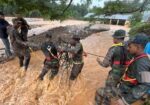Wayanad Landslides Spark Urgent Call for Improved Early Warning Systems

The devastating landslides in Kerala’s Wayanad district this week, which have claimed over 250 lives and left many missing, have intensified calls for better early warning systems (EWS) for landslides and debris flows. The tragedy has highlighted gaps in current warning systems and sparked a debate about how to enhance them.
Currently, the India Meteorological Department (IMD), Geological Survey of India (GSI), and National Disaster Management Authority (NDMA) issue alerts on heavy rainfall and potential landslides. The Central Water Commission provides flood alerts based on data from IMD and river monitoring.
Union Coal Minister G Kishan Reddy recently inaugurated the National Landslide Forecasting Centre (NLFC) in Kolkata, with plans to roll out regional Landslide Early Warning Systems (LEWS) nationwide by 2030. The NLFC is designed to provide real-time data and updates, helping local administrations and communities better prepare for landslides.
However, the GSI’s Wayanad center, which was expected to use advanced technology to forecast landslides, failed to predict the recent catastrophe. On July 29, the center’s advisory underestimated the risk, rating it as ‘low’ despite heavy rainfall. V Ambili, deputy director general at the GSI, admitted that the system was still experimental and the data was not intended for public use.
Union Home Minister Amit Shah stated in Parliament that the NDMA had issued warnings about potential landslides a week before the incident. Kerala Chief Minister Pinarayi Vijayan contested this, claiming that no “red” alert was issued for heavy rainfall.
Experts point out that predicting the scale of landslides remains challenging due to technological limitations. According to Sajinkumar K S, a landslide expert at Kerala University, essential data like soil thickness and real-time weather measurements are lacking. The current methods rely on sensors, satellite data, and numerical models, but do not adequately address the complexities of landslide pathways.
Dr. K V Uday from IIT-Mandi, who is testing landslide prediction methods in Himachal Pradesh, notes that real-time data on slope movements and rainfall is crucial for accurate forecasting. His team’s work in Himachal has improved landslide prediction, helping to mitigate damage.
Professor Deepankar Choudhury from IIT-Bombay emphasizes the importance of integrating satellite data with ground-level monitoring to predict landslides more effectively. He also highlights the impact of human activities, such as unplanned vegetation and drainage systems, which can exacerbate landslides by altering natural water flow.
In response to the Wayanad disaster, Kerala University is developing a mobile app to provide real-time landslide information to local communities. The National Remote Sensing Centre (NRSC) has also created a landslide atlas for 17 states and 2 Union Territories, revealing that Kerala has experienced 6,039 landslides between 2014 and 2021. Although this number is lower than in some northern and northeastern states, the high population density in Kerala makes its landslide risk particularly severe.
Kerala’s government is working on landslide prediction projects, including rainfall threshold studies and prediction systems led by the Kerala Development & Innovation Strategic Council (K-DISC). However, these initiatives are still in the pilot phase and have not yet been fully implemented.
Experts agree that improving early warning systems, integrating historical and real-time data, and addressing the impact of human activity are crucial steps towards reducing the risk and damage of landslides in vulnerable regions.
















Hi, this is a comment.
To get started with moderating, editing, and deleting comments, please visit the Comments screen in the dashboard.
Commenter avatars come from Gravatar.